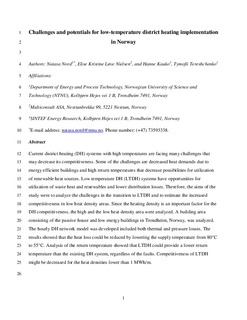| dc.contributor.author | Nord, Natasa | |
| dc.contributor.author | Nielsen, Elise Kristine Løve | |
| dc.contributor.author | Kauko, Hanne | |
| dc.contributor.author | Tereshchenko, Tymofii | |
| dc.date.accessioned | 2019-02-13T10:08:55Z | |
| dc.date.available | 2019-02-13T10:08:55Z | |
| dc.date.created | 2018-06-12T12:19:10Z | |
| dc.date.issued | 2018 | |
| dc.identifier.citation | Energy. 2018, 151 889-902. | nb_NO |
| dc.identifier.issn | 0360-5442 | |
| dc.identifier.uri | http://hdl.handle.net/11250/2585181 | |
| dc.description.abstract | Current district heating (DH) systems with high temperatures are facing many challenges that may decrease its competitiveness. Some of the challenges are decreased heat demands due to energy efficient buildings and high return temperatures that decrease possibilities for utilization of renewable heat sources. Low temperature DH (LTDH) systems have opportunities for utilization of waste heat and renewables and lower distribution losses. Therefore, the aims of the study were to analyze the challenges in the transition to LTDH and to estimate the increased competitiveness in low heat density areas. Since the heating density is an important factor for the DH competitiveness, the high and the low heat density area were analyzed. A building area consisting of the passive house and low energy buildings in Trondheim, Norway, was analyzed. The hourly DH network model was developed included both thermal and pressure losses. The results showed that the heat loss could be reduced by lowering the supply temperature from 80 °C to 55 °C. Analysis of the return temperature showed that LTDH could provide a lower return temperature than the existing DH system, regardless of the faults. Competitiveness of LTDH might be decreased for the heat densities lower than 1 MWh/m. | nb_NO |
| dc.language.iso | eng | nb_NO |
| dc.publisher | Elsevier | nb_NO |
| dc.rights | Attribution-NonCommercial-NoDerivatives 4.0 Internasjonal | * |
| dc.rights.uri | http://creativecommons.org/licenses/by-nc-nd/4.0/deed.no | * |
| dc.title | Challenges and potentials for low-temperature district heating implementation in Norway | nb_NO |
| dc.title.alternative | Challenges and potentials for low-temperature district heating implementation in Norway | nb_NO |
| dc.type | Journal article | nb_NO |
| dc.type | Peer reviewed | nb_NO |
| dc.description.version | acceptedVersion | nb_NO |
| dc.source.pagenumber | 889-902 | nb_NO |
| dc.source.volume | 151 | nb_NO |
| dc.source.journal | Energy | nb_NO |
| dc.identifier.doi | 10.1016/j.energy.2018.03.094 | |
| dc.identifier.cristin | 1590691 | |
| dc.relation.project | Norges forskningsråd: 245355 | nb_NO |
| dc.relation.project | Norges forskningsråd: 262707 | nb_NO |
| dc.relation.project | Norges forskningsråd: 286183 | nb_NO |
| dc.description.localcode | © 2018. This is the authors’ accepted and refereed manuscript to the article. Locked until 19-3-2020 due to copyright restrictions. This manuscript version is made available under the CC-BY-NC-ND 4.0 license http://creativecommons.org/licenses/by-nc-nd/4.0/ | nb_NO |
| cristin.unitcode | 194,64,25,0 | |
| cristin.unitname | Institutt for energi- og prosessteknikk | |
| cristin.ispublished | true | |
| cristin.fulltext | postprint | |
| cristin.qualitycode | 2 | |

